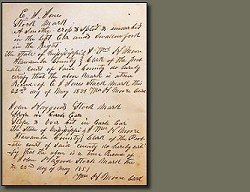 The Tombigbee River runs the entire length of the county north to south. From its headwaters along the northern border to its confluence with Bull Mountain Creek along the Monroe County line to the south, this river valley is home to vast areas of wetlands and swamps. Called “the bottom” by locals for generations, this area has been basically a no man’s land not fit for human habitation. In some places this area is two to three miles wide and where tributaries empty into the river, swamps were created.
The Tombigbee River runs the entire length of the county north to south. From its headwaters along the northern border to its confluence with Bull Mountain Creek along the Monroe County line to the south, this river valley is home to vast areas of wetlands and swamps. Called “the bottom” by locals for generations, this area has been basically a no man’s land not fit for human habitation. In some places this area is two to three miles wide and where tributaries empty into the river, swamps were created.Before the county road levee system was created and bridges were built, this area created a virtual barrier between eastern Itawamba and western Itawamba. During the wet season practically all travel across the river region ceased. During January of 1844 Itawamba County pioneer Josiah Hinds of western Itawamba County wrote in his diary: “Was at Fulton yesterday. Had to wade through Bigby Swamp. Got wet and don’t feel well.”
 By 1860 Itawamba County had five ferries across the river including Walker’s Crossing, the Fulton Ferry on the old Fulton and Pontotoc Public Road, Bean’s Ferry, Ironwood Crossing and Barr’s Ferry. Although the ferries made crossing the river itself easier, the traveler still had to make their trek through the river bottomlands, oxbow lakes and swamps, and the road levees were primitive at best.
By 1860 Itawamba County had five ferries across the river including Walker’s Crossing, the Fulton Ferry on the old Fulton and Pontotoc Public Road, Bean’s Ferry, Ironwood Crossing and Barr’s Ferry. Although the ferries made crossing the river itself easier, the traveler still had to make their trek through the river bottomlands, oxbow lakes and swamps, and the road levees were primitive at best.Over the years the Bigby Swamp has been the source of many legends and lore. From hidden Confederate gold and highway robbers to ghosts and moonshiners, this remote area of the county has produced many colorful tales and legends.
Today the Tombigbee River bottomlands continue to be a beautiful wildlife refuge area with a rich history and heritage dramatically cutting through Itawamba County from north to south.





No comments:
Post a Comment